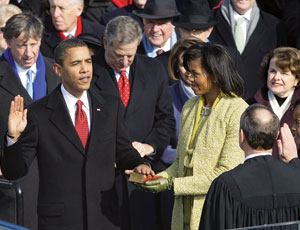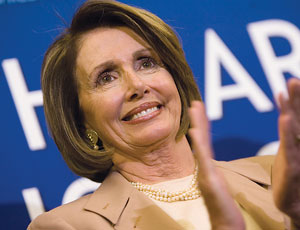In his Jan. 20 inaugural address, President Barack Obama focused on broad themes, asking his vast audience to �begin again the work of remaking America.� He said the economy needs �action, bold and swift� and then got more specific, talking about building �roads and bridges and electric grids.� That phrase no doubt grabbed the attention of recession-wounded construction officials who hope that their immediate priority, an infrastructure-oriented economic stimulus bill, also will rise to the front of the new President�s agenda.


House Democrats, led by Speaker Nancy Pelosi (Calif.), didn�t wait until Obama was sworn in to unveil a hefty �economic recovery� proposal. Their $825-billion package, released on Jan. 15, would inject $550 billion in new spending and $275 billion in tax cuts into the ailing economy. As drafted, the plan�s spending side has more than $150 billion for construction-related programs, by ENR�s calculation. Some of the tax incentives also promise to give construction a boost, including an extension of a writeoff for equipment and other capital goods.
Obama, whose advisers worked with Pelosi and her team in designing the proposal, praised the draft bill as �a significant down payment on our most urgent challenges.�
Release of the Democrats� plan will intensify the stimulus debate and give industry plenty on which to chew. Among the bill�s largest construction allotments are those for highways, schools and energy-efficiency upgrades (table). It also would fund maintenance and repairs at an array of federal buildings, spread among agencies from the Defense Dept. to Centers for Disease Control and Prevention. Stephen E. Sandherr, the Associated General Contractors� CEO, says, �Over all, it�s impressive.� But he adds, �No one should expect that this is a done deal.�
Pelosi also cautions, �This is the first step along the way.� House committees were slated to vote on the package right after the inauguration. Pelosi says the bill will move to floor for action during the week of Jan. 26. The Democrats� House majority, enlarged by gains in November�s elections, should help the Speaker keep the package close to the initial draft.
The measure then would move to the Senate, which may well modify what the House produces. �We try to minimize the differences going in, but I would be surprised�and I am rarely surprised�if [House and Senate plans] would be identical,� she says. She wants to have the final bill to Obama by Feb. 13, when the Presidents� Day recess starts.
The proposal�s $150 billion-plus for public works is a significant sum, but some in the pro-infrastructure camp complain that it�s not enough. Terence M. O�Sullivan, general president of the laborers� union, says, �Any step forward is progress, but this level of investment falls far short of needs and fails to fully take advantage of the opportunity to put America back to work building the essential and long-neglected basics of our country.�
Rep. Peter DeFazio (D.-Ore.), a senior Transportation and Infrastructure Committee member, says by his reckoning, �real infrastructure investment� would comprise only about 7.5% of the package, a percentage he says is inadequate. DeFazio appears to be referring to the $63 billion in the proposal that would go to highways, transit, airports and other programs under the transportation committee�s jurisdiction. In a December proposal to Pelosi, transportation panel Chairman James Oberstar (D-Minn.) recommended a total of $85 billion for those programs.
DeFazio suggested at a Jan. 15 meeting that the committee consider sending House Democratic leaders a formal message, conveying the view that �we need a much more substantial number on proven needs for projects that can put people to work and make our transportation more effective.�
Construction groups will try to convince the Senate to move the House public-works numbers upward. Industry officials now are digging into the House plan�s details. The bill has no earmarks, a point that Democrats hope will speed passage and appease critics of �pork� projects. Much of the spending would be distributed to states or localities by existing formulas, but those formulas differ from program to program.
The House proposal also stresses oversight, and hikes funding for federal agencies� inspectors general and the Government Accountability Office to keep tabs on where the stimulus money goes. Oberstar plans hearings �every 30 days� to monitor stimulus progress in areas under his panel�s jurisdiction, including highways, transit, airports, federal buildings and wastewater treatment programs. He wants reports on who gets contracts, how many jobs are produced per worksite and the impact on construction-materials suppliers� workforces.
| Total Construction-Related Spending: $159 billion | |||
|---|---|---|---|
| Transportation | $43.8 billion | Includes federal-aid highways | $30 billion |
| Energy | $36 billion | Includes electricity grid investment | $11 billion |
| Housing/HUD | $13.3 billion | Includes public housing repair, construction | $5 billion |
| Defense/Veterans | $11.5 billion | Includes DOD hospitals, surgical centers | $3.8 billion |
| Schools | $20.1 billion | Includes K-12 renovation, repair | $14 billion |
| Health and Human Services Buildings | $4.1 billion | Includes NIH aid for university research facilities | $1.5 billion |
| Other Buildings | $12.9 billion | Includes GSA energy-efficiency upgrades | $6 billion |
| Water and Environment | $17.1 billion | Includes EPA clean water state revolving fund | $6 billion |
| Other | $575 million | Includes Bureau of Land Management, infrastructure, buildings maintenance | $325 million |
| NOTES: NUMBERS ARE ROUNDED. SOME CATEGORIES PROVIDE FUNDING FOR CONSTRUCTION AND NON-CONSTRUCTION CAPITAL SPENDING SOURCES: HOUSE APPROPRIATIONS COMMITTEE, ENR | |||
House Appropriations Committee Chairman David Obey (D-Wis.), the chief author of the proposal�s $550-billion spending section, calls the measure �simply the largest effort by any legislative body on the planet to try to take government action to prevent economic catastrophe.� But he notes even a plan of that magnitude �may be insufficient� to meet the goal. �We may need to do even more at a later date,� Obey says.



Post a comment to this article
Report Abusive Comment